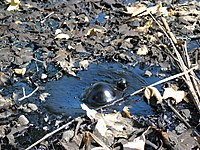
Photo from wikipedia
Abstract Rigorously studied and dated Late Quaternary paleoenvironmental reconstructions from Ranch La Brea (RLB) and the Los Angeles Basin are scarce. Here, we use data from AMS radiocarbon dated insect… Click to show full abstract
Abstract Rigorously studied and dated Late Quaternary paleoenvironmental reconstructions from Ranch La Brea (RLB) and the Los Angeles Basin are scarce. Here, we use data from AMS radiocarbon dated insect fragments to infer local climates over the past 50,000 years. Our results indicate: 1) Quaternary insect remains can be located with great accuracy in radiocarbon time, and 2) well-dated and documented climate indicator beetle species are sensitive proxies for environmental change in the Los Angeles Basin. A total of 182 extant RLB ground and darkling beetle species (Coleoptera: Carabidae, Tenebrionidae) were radiocarbon dated. The resulting radiocarbon dates form a semi-continuous range from ∼50 to 28, 16–7.5, and 4 kcal yrs BP to the present. Associated insect climate ranges indicate past conditions consistent with, or very similar to, the current Los Angeles Basin Mediterranean climate. Importantly, these insect data suggest higher temperatures and aridity than inferred previously from other RLB proxies. Furthermore, wider-than-assumed dating spreads for some deposits emphasize the lack of biostratigraphy for RLB, and challenge inferences based on limited sets of radiocarbon dates and assumptions about stratigraphic integrity. Our results demonstrate the necessity to independently radiocarbon date each taxon. The insect paleoclimate interpretations were compared to regional pollen data, primarily from various southern Californian sites including Lake Elsinore and Santa Barbara Basin. These comparisons reveal an important difference in climate interpretations for the last Glacial: the RLB insect data suggest climate similar to the current one, while the regional pollen data have been interpreted as indicating a climate wetter than present.
Journal Title: Quaternary Science Reviews
Year Published: 2017
Link to full text (if available)
Share on Social Media: Sign Up to like & get
recommendations!